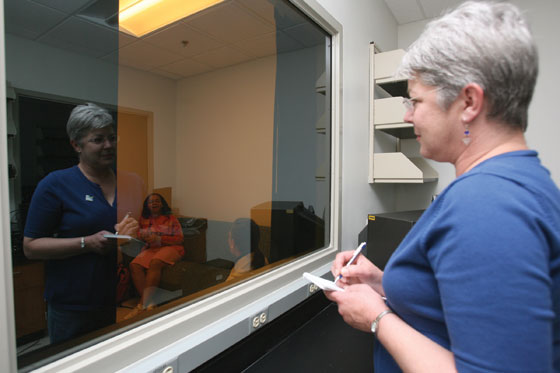A brisk morning's walk through ISC 2
Psychologists and biologists move in--and get a move on
You have to keep reminding yourself that you're inside what used to be Rogers Hall.
The venerable chemistry building has been gutted and transformed into a state-of-the-art working space now known as Phase 2 of the Integrated Science Center. The chemists aren’t around, either; they moved to new quarters in the first phase of the Integrated Science Center last summer.
The lion’s share of the psychology department is on the first floor of ISC 2. The second floor is occupied by biologists, whose new department headquarters is in the adjoining ISC 1. ISC 1 is new construction that opened last summer.
In late April, there was still some unpacking and setting up going on, but actual science was going on in most of the labs. The biologists had moved over from Millington Hall, as had most of the psychologists. The departments aren’t 100 percent consolidated, though; there are a few psych people left in the Bell Building and some biologists remain in Millington. In the ISC 2, much of the talk in both departments had to do with how much better things were.
“This is a nice, big open space,” psychologist Peter Vishton said, looking around his new facility. Vishton, who moved his lab over from cramped quarters in the basement of the Bell Building, works on studies involving visually controlled actions, especially in infants. “The parents will be more comfortable; that will make the babies more comfortable—and that will give us better data.”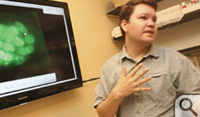 Joseph Galano, meeting with a graduate student (“For the first time, we have a window!”), said he usually works with seven or eight undergraduate students, researching prevention of child abuse and neglect, often in partnership with the group Prevent Child Abuse Virginia.
Joseph Galano, meeting with a graduate student (“For the first time, we have a window!”), said he usually works with seven or eight undergraduate students, researching prevention of child abuse and neglect, often in partnership with the group Prevent Child Abuse Virginia.
“I’m very fortunate here at William and Mary to have wonderful undergraduate students,” Galano said. “We used to work in a closet; now we have a wonderful research space.”
Constance Pilkington, psychology chair, paused outside the department conference room where a group was assembling to hear a senior’s honors project presentation.
“Our new seminar rooms provide us with a lot more space to host invited speakers and to have research meetings,” Pilkington said.
The ISC 2 benefits go beyond better, more pleasant and more convenient work spaces. Like the adjoining first phase of the Integrated Science Center, the ISC 2 was built with the needs of the scientists in mind. The psychologists, for example, now have a dedicated computer-driven research lab, no longer having to make do with a patched-together collection of machines.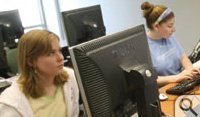 “Computers are our microscopes and our test tubes,” Pilkington said. “I know everyone uses computers, but we use computers to collect so much of our data. Using a computer, we can get reaction time and that tells us all sorts of things about what goes on in the brain. We collect physiological data and that tells us about your emotional state.”
“Computers are our microscopes and our test tubes,” Pilkington said. “I know everyone uses computers, but we use computers to collect so much of our data. Using a computer, we can get reaction time and that tells us all sorts of things about what goes on in the brain. We collect physiological data and that tells us about your emotional state.”
The psych department’s new computer infrastructure even extends to a pair of Faraday chambers, electrically shielded booths that allow researchers in the EEG lab to get better data when they monitor brain activity in human subjects.
“Right now these fluorescents are flickering at 60 hertz—that’s 60 times a second,” Assistant Professor Paul Kieffaber explained. “All the outlets in the walls, they are pulsating with alternating current. All of this creates electrical noise. The sensors that we use to record brain activity are so sensitive that they pick up on all this kind of environmental noise; in fact that noise is much louder than the kind of activity that we’re able to record at the surface of the scalp.”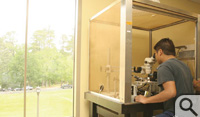 Kieffaber said until the Faraday chambers were installed, researchers used software to filter out the electrical noise. “It’s easy. And,” he said, “it distorts your data.” Pilkington said that the shielded booths are almost never seen in a school the size of William & Mary, but will be valuable for a large part of the psychology faculty.
Kieffaber said until the Faraday chambers were installed, researchers used software to filter out the electrical noise. “It’s easy. And,” he said, “it distorts your data.” Pilkington said that the shielded booths are almost never seen in a school the size of William & Mary, but will be valuable for a large part of the psychology faculty.
“The cool thing about this is we’ve got cognitive psychologists, clinical psychologists, social psychologists, pretty much the whole spectrum of psychology can come in here and do brain recording,” she said.
Like the EEG lab, Pilkington said the department’s new dyadic interaction lab will see wide use. A suite of four interaction rooms are connected to an observation room by video as well as two-way mirrors.
“Because we have these four rooms in the suite, we can have people interacting together, then break them out into separate rooms,” Pilkington said. “We can watch everything that’s going on from the central control room.”
On the second floor, a similar metamorphosis was underway in biology labs.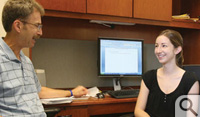 “It’s bright, it’s open. It’s a great place to be. This is really a great change,” said Matt Wawersik, a biologist who works with stem cells in fruit flies. “We have our own microscope room. Before, we just had this makeshift shell that was really a box we went into. We have the rooms across the way that are colloquium space that we can meet for teaching and for lunches or lab meetings.”
“It’s bright, it’s open. It’s a great place to be. This is really a great change,” said Matt Wawersik, a biologist who works with stem cells in fruit flies. “We have our own microscope room. Before, we just had this makeshift shell that was really a box we went into. We have the rooms across the way that are colloquium space that we can meet for teaching and for lunches or lab meetings.”
Opening of the Integrated Science Center Phase 2 is the latest milestone in the development of a science precinct at William & Mary. The first phase of the ISC opened for business in summer of 2008. Taken together, ISC 1 and 2 provide a total of 70 teaching and research laboratories (plus faculty offices and support facilities) for the departments of chemistry, biology and psychology. Plans are being developed for the third phase of the Integrated Science Center. 















